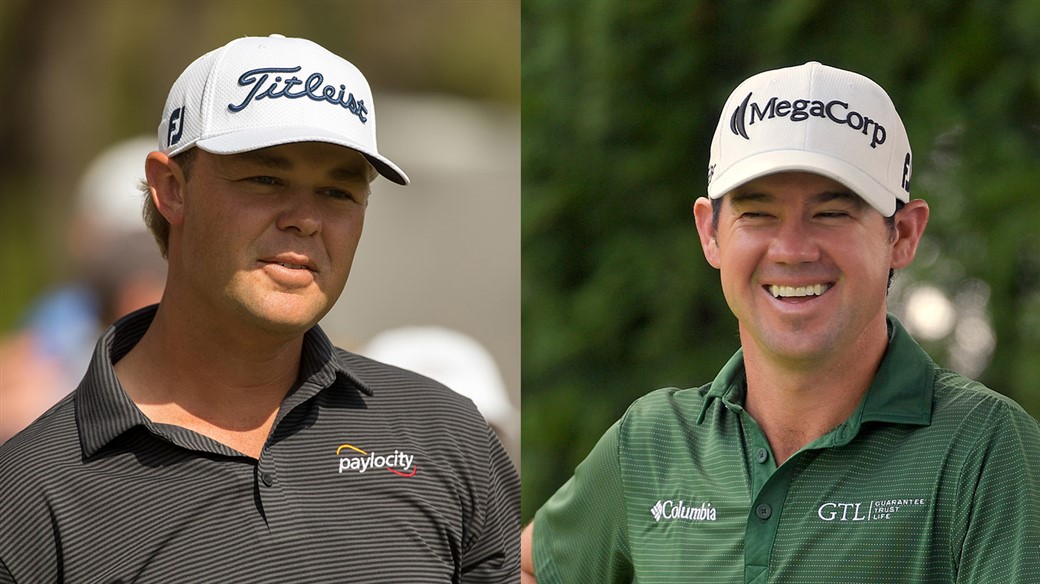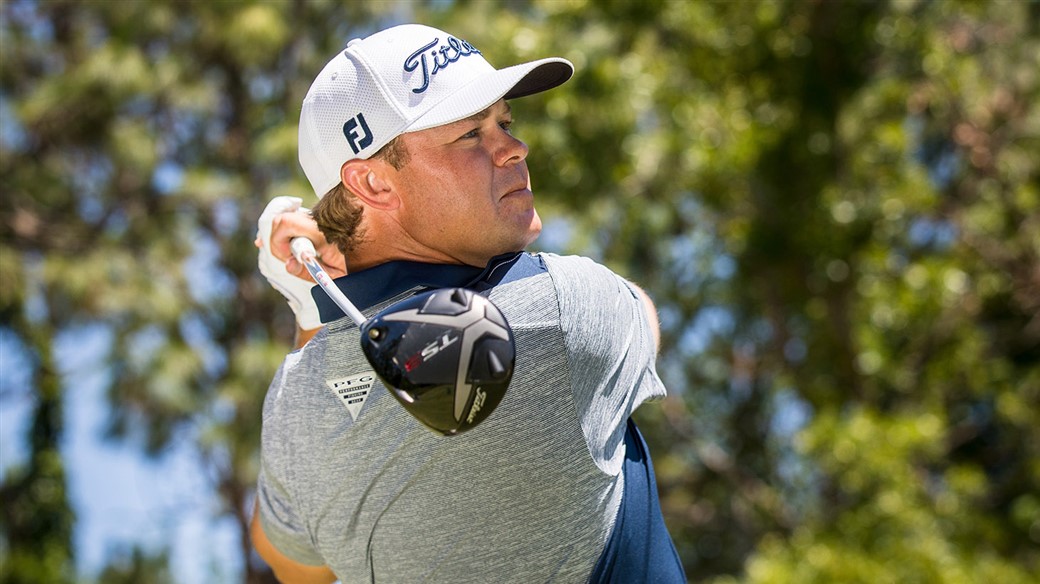
Though we're still several weeks away from their official global launch, the buzz continues to build this week around the New 2019 Titleist Pro V1 and Pro V1x golf balls. Good friends and fellow Titleist Brand Ambassadors Brian Harman and Patton Kizzire captured the final tournament on the PGA TOUR 2018 calendar, trusting the new 2019 Pro V1 and 2019 Pro V1x, respectively, in their victory at the QBE Shootout.
Though it was an unofficial event, this weekend's QBE Shootout attracted an elite field of two-player teams that produced some inspired golf. When Kizzire holed a 15-footer for eagle on the 72nd hole at Tiburón Golf Club, it capped a final-round 61 for the St. Simons Island, Georgia neighbors, who posted a 30-under total to win by one shot.
This is the time of year that players are looking ahead to the 2019 season, recharging their batteries and looking for an edge when it comes to equipment. Harman and Kizzire certainly found that this weekend in Naples, so for some insight into Brian and Patton's equipment, including their recent switch into the new 2019 Pro V1 and Pro V1x, we reached out to JJ Van Wezenbeeck, Titleist Director of Club Promotion on Tour, who shared some details.
Q: How long did it take Brian and Patton to transition into the new 2019 Pro V1 and Pro V1x?
JJ: Both Patton and Brian are Sea Island guys, so as we were rolling out the new 2019 models in Las Vegas, they both spent a lot of time with Fordie Pitts (Titleist Tour Consultant for Golf Ball Performance) as they headed home for the RSM Classic. They both saw some improvement in ball speed, which every player is looking for, while the balls still maintained the feel and control they’re used to.
Patton is a player who’s looking to add height and spin to his game, which is a perfect example of why X is a great choice for him. Brian is looking to control his spin and flight his irons a little, which is why V is a perfect product for him.
From a fitting standpoint, Brian knows all his condition numbers as well as anyone. He spent a lot of time on the launch monitor, looking at numbers, making sure that the ball was launching appropriately and spinning appropriately, where Patton is focused on looking up into his windows for each club and asking, “Hey, is that ball flying how I want?” They both saw some great reactions around the green and better speed, so it became an easy transition for both of them.
We’re always working from the green backward, we really think the wedges, the short game as well as your iron game is most important in fitting a golf ball. We can make so many adjustments with our TS drivers and fairways, that we can adjust the flight higher or lower to optimize the launch conditions for the ball that works best with that player’s wedges and irons.
Q: Patton is almost a foot taller than Brian. How different is their equipment because of that?
JJ: Their approach to fitting carries over on the club side, so Brian is very analytical. He focuses on ball speeds and launch conditions. Patton is much more, 'I’m gonna swing and you guys tell me what’s working.' Both guys have a feel for what they like, though, how shafts load and feel.
It’s interesting. Patton’s TS3 driver is 1/2-inch short - 44 1/2 inches, mid 70’s weight shaft. Brian plays closer to 55 grams in his driver shaft and slightly long. Brian is looking to create speed where Patton is honing in on the direction and the centeredness of hit. As we get into irons, Brian is slightly short and Patton’s shafts are 3/4-inch long. So there’s not always a correlation based on a player’s build. It really requires individual fitting and how the player swings, how he delivers the club, how the shaft reacts with that particular club head.
Q: You mentioned Patton's TS driver. Tell us about that transition.
JJ: It was a two-part process for Patton, really. He was exposed to the TS very early in the prototype phase and was seeing some great ball speed increases, so he was clamoring for TS by the time we launched it at the U.S. Open. Through the summer we saw an opportunity to tighten up his driving as he made some swing changes. As part of a player's team, we’re always involved in optimizing equipment as players do make adjustments to their technique.
So, with Patton, we moved to a slightly different shaft, which is a touch stiffer in the midsection. With that change and by fine-tuning the right shaft length, we were able to get much better center face contact. We were able to maintain launch with his 10.5° head and keep his spin under control. He now has more of a one-way shot shape, where previously he had a little more play in the shaft that could result in a two-way miss at times.
Q: Do you see Brian moving into the TS driver soon?
JJ: I do. We've done some initial testing where we've seen really good ball speeds for Brian with TS and it's really just a case of getting more time with him. These guys' schedules are very full with golf and life, but this will be something we'll work on together throughout December, where he can get some time away from tournament golf to test further.
Q: Lots of Vokey SM7 wedges in both Patton's and Brian's bags. Do they approach wedge fitting differently, too?
JJ: Aaron (Vokey Tour Representative, Aaron Dill) works with these guys every week. Brian is very set and specific and Aaron spent a lot of time hand-grinding wedges to get the ball to do exactly what Brian wanted on specific shots. Patton on the other hand, worked a lot this fall, trying out a number of diverse grinds. He and Aaron came up with a signature modification on his 60-K lob wedge.
Q: Patton also uses a mixed set of irons. How do you as a fitter know where in the set to switch models?
JJ: This is part of the fitting process with all our players. It gets difficult in gapping with Tour players sometimes because they hit the driver so far, but they still only get to use 14 clubs like you and I do. So the big key is looking at where we want help and where we need to spread things out.
Someone like Patton, who’s playing four Vokey wedges, we’re going to work off that, because he wants all that help when he’s in the scoring zone. So as we’re progressing through his bag, we have to stretch gaps out as we get higher in his bag. But we also want to make sure we’re keeping his peak heights up, so that if he has a 4-iron into a green it’s still going to have some stopping power. So that’s why we process from 718 MB in a short iron to 718 CB in a mid-iron. That allows us to have a little bit better vertical window.
And then as we progress from his irons to his hybrid, the 718 T-MB not only gives us the height, but it gives us some ball speed, too, so that helps stretch that gap between his 4- and 5-iron.
You look to learn from Patton's example, where we saw a chance for improvement starting between the 6- and 7-iron. I think a lot of consumers can really work with a fitter and spend time looking at their whole bag rather than just walking in and saying, "I'm just going to get a 3-iron through pitching wedge and go play golf." That top end of the bag is really a big area that a lot of amateur golfers can see improvement through some fitting.
• • •
Let's take a closer look at all the Titleist equipment that Patton and Brian relied on to win in Naples.

PATTON'S WINNING SETUP:
Golf Ball: NEW 2019 Pro V1x
Driver: TS3 (10.5º)
Fairway: 917F2 (15º)
Hybrid: 913H (19°)
Irons: 718 T-MB (4), 718 CB (5-6), 718 MB (7-9)
Wedges: Vokey Design SM7 pitching (48.10 F Grind), gap (52.12 F Grind), sand (56.08 M Grind) and lob (60.06 K Grind)
Putter: Scotty Cameron GoLo Tour

BRIAN'S WINNING SETUP:
Golf Ball: NEW 2019 Pro V1
Driver: 917D2 (9.5º)
Fairway: TS2 (13.5º), 917F2 (18°)
Hybrid: 818 H1 (21°)
Irons: 718 CB (5-9)
Wedges: Vokey Design SM7 pitching (46.08 F Grind), gap (50.08 F Grind), sand (54.10 S Grind) and lob (59.04 L Grind prototype)
• • •
Thanks for spending some time with us, JJ and congratulations to Brian and Patton on your Shootout victory!
#TeamTitleist